The Samsung Galaxy S7 and S7 edge Review: Part 2
by Joshua Ho on July 5, 2016 8:00 AM ESTCamera Architecture and UX
In general, camera has become probably the single biggest point of differentiation between smartphones at this point. As smartphones are often the only camera that most people carry on a day to day basis, the rear camera on a smartphone really cannot be a disappointment relative to the competition. While we can talk about how much a front-facing camera matters in terms of quality, it’s pretty safe to say that for photos and videos that are worth saving will be taken with the rear-facing camera.
While post-processing and a number of other factors are going to have a huge impact on the overall camera experience, the foundation that makes it possible to deliver a great camera is always going to start at the hardware.
| Samsung Galaxy S Cameras | ||||
| Galaxy S6 Galaxy Note5 |
Galaxy S7 | |||
| Front Camera | 5.0MP | 5.0MP | ||
| Front Camera - Sensor | Samsung S5K4E6 (1.34 µm, 1/4.1") |
Samsung S5K4E6 (1.34 µm, 1/4.1") |
||
| Front Camera - Focal Length | 2.2mm (22mm eff) | 2.1mm (21mm eff) | ||
| Front Camera - Max Aperture | F/1.9 | F/1.7 | ||
| Rear Camera | 16MP | 12MP | ||
| Rear Camera - Sensor | Sony IMX240 Samsung S5K2P2 (1.12 µm, 1/2.6") |
Sony IMX260 Samsung S5K2L1 (1.4 µm, 1/2.6") |
||
| Rear Camera - Focal Length | 4.3mm (28mm eff) | 4.2mm (26mm eff) | ||
| Rear Camera - Max Aperture | F/1.9 | F/1.7 | ||
In the case of the Galaxy S7, Samsung has done something that I thought they’d never do, which is move backwards in resolution in order to improve pixel sensitivity. In the case of the Galaxy S7, Samsung has moved from the Sony IMX240/Samsung S5K2P2 to the Sony IMX260/Samsung S5K2L1 sensor, with a 1.4 micron pixel size relative to a 1.12 micron pixel pitch in the previous generation. This means that there’s a 56% increase in sensitivity per pixel. Assuming the same process technology, this does improve low light performance significantly. While to some extent it’s true that improved CIS (CMOS image sensor) technology can alleviate the downsides of smaller pixels, on the same technology you have to reduce your fill factor/active sensor area. The other problem is that while read noise on the sensor does reduce per pixel as you reduce pixel size, the overall sensor read noise trends upwards. This means that the region in which the CIS noise is primarily limited by shot noise is going to be smaller as you reduce pixel size. Shot noise is an unavoidable reality of existence, to the extent that even our eyes can see this “visual snow” if ambient light is sufficiently dim.
However, in the case of the Galaxy S7 I suspect that there’s more to the story, because the dual pixel AF system means that for each 1.4 micron pixel each pixel needs two photodetectors. In order to make phase detection work, there has to be sufficient spatial separation to make this system work properly, so some of the benefit of these larger pixels will inevitably be eaten up in order to enable PDAF that works in basically all lighting conditions.
The other notable change here is that the Galaxy S7 uses an even wider f/1.7 aperture. Unfortunately, in Samsung's efforts to try and make the module thinner they've made the focal length slightly shorter than before which results in an effective focal length of 26mm. This and the wider aperture could lead to compromises as light is entering the optics at a more extreme angle than before.
With these basics covered, we can move on to a discussion of the user experience. While in the past it was easy enough to just take some still shots on a tripod, a holistic view of camera quality really needs to take into account far more than just the end result. A poorly designed camera application with low resolution, low frame rate preview, improper preview aspect ratio, poor control layout, and other issues can easily make it difficult, if not impossible to get the photo that you want. These issues are thankfully getting less common, but these problems can make it almost impossible to recommend a phone for its camera, no matter how good the results are.
In the case of the Galaxy S7, the camera application is a nice upgrade over the Galaxy S6 at launch, but for the most part nothing is really different this go around. I’m not going to spend too much time here, but the short story is that I don’t think that Samsung is doing anything wrong here, and things are pretty much as good as they’re going to get.
While leaving it at that would be enough, I want to recognize some of the improvements that Samsung has implemented here. The major improvement here is that Pro mode is finally useful, as this mode now allows for adjusting auto-exposure and AF targets, in addition to EV, shutter speed, ISO, white balance with 100K granularity, and manual focus. The one notable shortfall here is that Samsung only allows 800 ISO max in manual ISO mode when the true maximum is 1250. For better or worse though, that’s the only notable problem I encountered with the camera app itself. It’s easy to think that Samsung hasn’t done anything notable here, but this is more a testament to the execution of design more than anything else.
However, before we move on to image quality testing, we can take a look at our focus and capture latency tests. For those that are unfamiliar, this is a fairly simple test designed to see how long it takes for a phone to focus and capture a scene on our standard ISO test chart in good lighting conditions, which can give a fairly good idea for best case latencies.
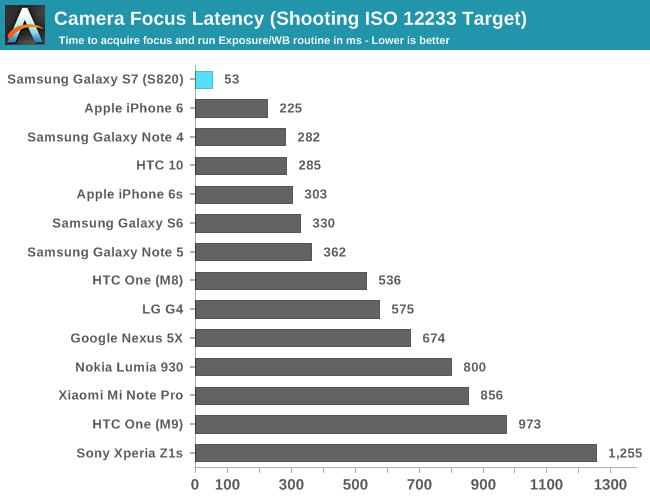
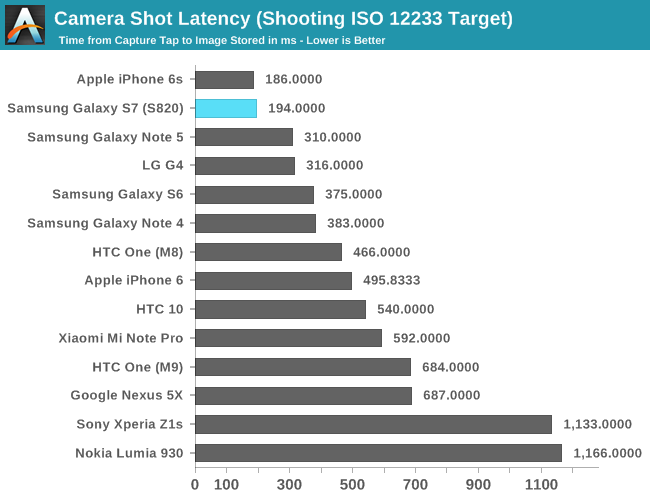
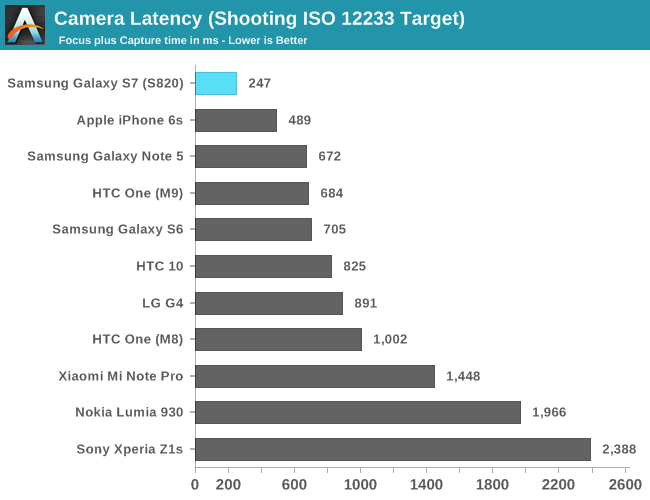
It’s probably not a surprise, but the Galaxy S7 is really, absurdly quick to take photos and focus. There is nothing out there that can realistically match the dual pixel AF system in the Galaxy S7, especially once you get into low light scenarios where traditional PDAF systems are overwhelmed by noise that can’t be easily canceled out. Samsung’s sheer prowess in semiconductor design and manufacture is really showing here, even in the best case.


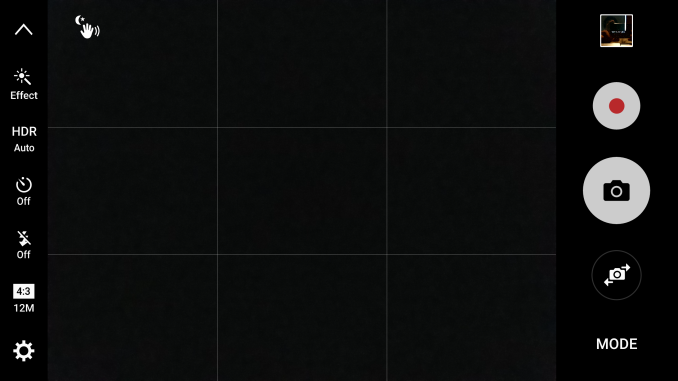
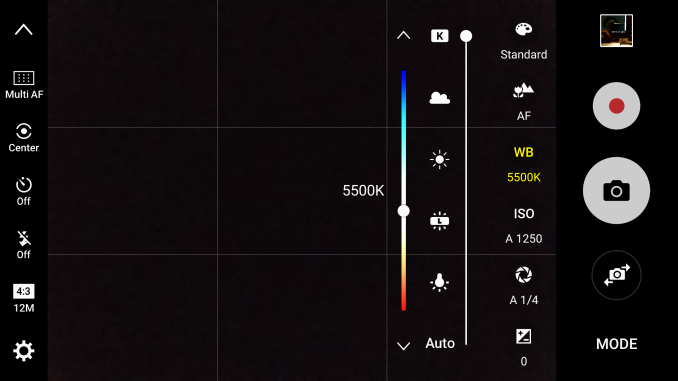
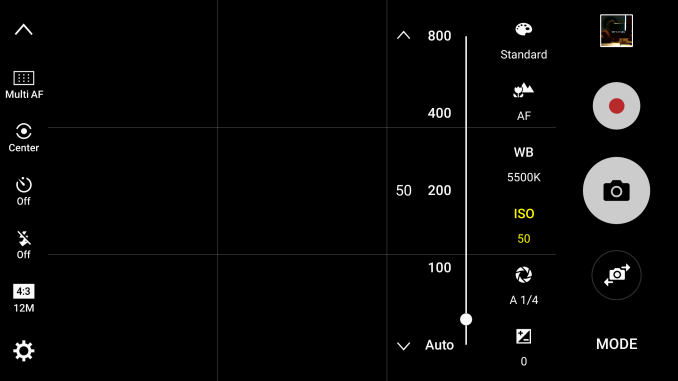








266 Comments
View All Comments
realbabilu - Thursday, July 7, 2016 - link
Yes, Rbrowser is very fast, since it optimized for snapdragon, but still doesn't have cpu internal Javascript decoder like nitro.lilmoe - Wednesday, July 6, 2016 - link
Well, JetStream says that my Core i7 4700MQ is only 15% faster than Apple's A9.Just ignore browser benchmarks bro. They're just here to make reviewers feel better about their iPhone...
TheinsanegamerN - Tuesday, July 5, 2016 - link
HOLY @#*% FINALLY!*goes to read article
TheinsanegamerN - Tuesday, July 5, 2016 - link
Alright, after reading the review I can say:Still not worth $600-$700. Battery life is improved, but man junkwiz is an issue. Its too bad there is no longer a GPe store, as the s7 would make a nice contender. Still a non starter due to the sealed battery, but would be better if stock android was installed. Will be interesting to see what the CM community cooks up for it.
retrospooty - Tuesday, July 5, 2016 - link
" too bad there is no longer a GPe store"- That would be great to see... The hardware is really great, but the lousy Samsung software kind of gives is a black eye IMO. Seriously Samsung, just lay off 95% of your software devs and release stock Android phones. You are spending ridiculous amounts of money to make your phones worse. Software is NOT your strong-suit - use your strengths and stop wasting time with your weakness.
ph00ny - Tuesday, July 5, 2016 - link
Do you guys actually use the latest samsung devices? I'm on Note 5 and i don't have any issues with the TW at all. In fact when i occasionally use my spare Nexus 4 for plex in the bedroom, it feels very spartan. I haven't felt the need to root or install custom firmware in many years and i was a habitual custom firmware flasher back in the daysretrospooty - Tuesday, July 5, 2016 - link
Yes, I have had the S7 Edge since March and love it. Day one, I disabled every single Samsung app and every single Verizon app (except for a few that you cannt without root) and the phone is great, battery life is absolutely amazing. The screen is amazing. I love this phone, but Samsung software is absolute crap. I never had an issue with TW, it's the bloatware that sucks. Useless poorly written apps that do nothing but slow you down.ph00ny - Tuesday, July 5, 2016 - link
Like which samsung app? When i got my AT&T Note 5, first thing i did was disable dozen or so AT&T bloat but large portion of the samsung apps were left as is. I have samsung pay, all the note related apps, samsung app store, s-health (i actually use this over google fit)retrospooty - Tuesday, July 5, 2016 - link
All of them. The email app, the VR apps and services, s-health, s-voice, app store, and many many many others. All crap that collectively slow you down. I know some people use some of it, like you say you use s-health. Wouldn't it be nice if the device booted up clean and you had the option to load only s-health and the ones you want instead of having them all shoved onto your ROM and running, consuming memory ? Is it just me?jospoortvliet - Wednesday, July 6, 2016 - link
It isn't just you, I hate all of it too. Turned off what I could, did my best to limit the abilities of the rest but - what a stupid pita. Points for HTC getting rid of that stuff, almost thinking I should've waited for the HTC 10. These apps really are annoying. And yes, uselessly eating ram and battery... sjees.